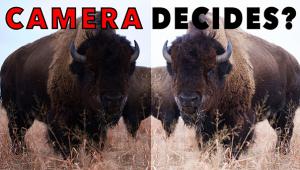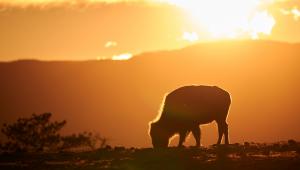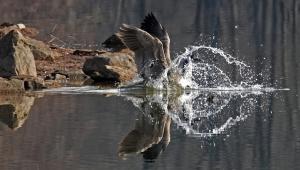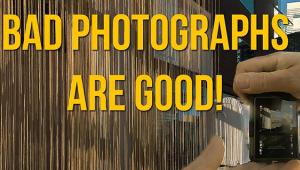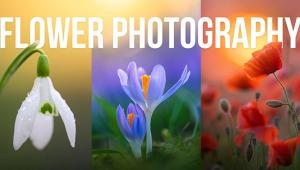Locations: Winter In Yellowstone: A Photographic Wonderland
Winter is an extraordinary time in Yellowstone. Temperatures often plummet well below zero. Moisture ejected into the icy air from myriad thermal features creates a microclimate that turns into a wintry fairyland. The colder it becomes, the more pronounced these effects, and the more beautiful the surroundings become. Whether it’s wildlife, geothermal features, extraordinary scenery, or any combination thereof, Yellowstone National Park (YNP) is, hands down, one of the best places in the world to view and photograph these treasures.

All Photos © Rick Sheremeta
Wildlife
As beautiful as winter can be in Yellowstone, unforgiving weather and scarcity of food make it an extremely hard time for wildlife to endure. It is of the utmost importance when photographing wildlife to give them adequate space and not cause them undue stress—any unnecessary activity or flight from a threat results in consumption of precious calories needed to survive the brutality of winter.
It’s possible to stumble upon wildlife anywhere in YNP. However, there are certain locations where the odds will definitely pay off. My favorite areas for photographing wildlife are in the northern end of the park—Blacktail Plateau/Lamar Valley and Gallatin Valley. Both locations are completely accessible to motor vehicles year-round, and winter traffic is generally light.
US Highway 89 connects Mammoth with Cooke City through the Lamar Valley. This is always a great place to spot wildlife. Elk may be present along the entire route, but are more likely to be seen between Mammoth and Tower Junction in forested areas of the Blacktail Plateau. Bison are prevalent throughout; coyote and red fox are also common. A good location to find bighorn sheep is near the confluence of Lamar River and Soda Butte Creek, at the base of Druid Peak. River otter and American dipper also frequent this area. Beyond Soda Butte, one may occasionally come across a moose. Wolves are present throughout YNP but are scarcely seen up close, although it does occasionally occur. Keep an eye peeled for folks glued to spotting scopes at road pull-offs—a good bet they’re viewing wolves off in the distance.

My other preferred region for wildlife is the Gallatin Valley. This area is just west of Gardiner, and is accessed along Old Yellowstone Trail. Bison, elk, pronghorn antelope, coyote, and bighorn sheep are often observed here.
Fewer animals will generally be encountered within the park’s interior. There are, however, exceptions where bison especially can be abundant. One such locale is along the Madison River between West Yellowstone and Madison Junction. A second is along the Firehole River, from Madison to Old Faithful. Bald eagles and waterfowl may also be found in these locations. The Lower, Middle, and Upper Geyser Basins afford yet more chances to see bison.

Thermal Features
Yellowstone contains more hydrothermal features than anywhere else, with over 10,000 hot springs, geysers, mud pots, and steam vents. Many thermals are located in remote, inaccessible areas. None are as reliable or timely as Old Faithful, nor are many as spectacular, or photogenic—but that’s the challenge of photographic creativity. Fortunately, many of the major active features are located within the Upper, Middle, Lower, and Norris Geyser Basins—within easy reach of the main road’s snowcoach and snowmobile tour routes.
The Upper Geyser Basin is within short walking distance of Old Faithful Visitor Center and Snow Lodge (both open in the winter). The Terraces at Mammoth Hot Springs are within walking distance from the Mammoth Hot Springs Hotel—a short car ride to the Upper Terrace may be a more preferable way to explore this area. Geothermal features at West Thumb and Hayden Valley can be reached via snowmobile but are generally beyond the reach of many snowcoach tours. All geyser basins have paths and/or boardwalks; none, however, are maintained in winter so they can be ice covered and treacherous.

Landscape
Yellowstone has some of the most varied and beautiful landscape to be found in the lower 48—mountains, prairies, rivers, canyons, waterfalls, and lakes. The Grand Canyon of the Yellowstone is spectacular, and is found in the Canyon area of YNP. Snowcoach, snowmobile, and cross-country skiing excursions are regularly scheduled from Mammoth, West Yellowstone, and Old Faithful. It is here that you will also find the famed Upper and Lower Falls of the Yellowstone River. Of the two, the Lower Falls (at 308 feet and three times higher than the Upper Falls) is the more spectacular. It can be viewed from the North Rim Scenic Drive. The Upper Falls is observable from the South Rim Drive. A couple of other notable falls are Firehole Falls, located along Firehole Canyon Drive, and Gibbon Falls, along the road between Madison and Norris.

Winter Photography
Winter in YNP is harsh and can be extremely cold. Temperatures well below zero with extreme wind chill are not uncommon. It is advisable to be prepared with adequate and proper clothing. This is a whole subject unto itself and well beyond the scope of this article. Suffice it to say that layering with breathable synthetic or wool inner garments, along with breathable, windproof, and water-resistant outer clothing are recommended.

Photo Gear
Resist the temptation to bring every conceivable piece of camera gear you own. No matter how you travel in YNP, space will be at a premium. Passengers are limited to one bag inside a snowcoach, and can’t get much more on a snowmobile. A huge telephoto lens may be okay when shooting along the road from a car in Lamar Valley, but smaller, more manageable lenses are better suited elsewhere. Animals are often close to roads—a really big lens often won’t be necessary.
Here’s the gear I bring, and it all fits into a manageable pack. I use a Lowepro Rover Pro 45L. A wide-angle and a telephoto zoom lens handle most every situation. For me, a 28-70mm works for scenic landscapes, and a 70-300mm or 100-400mm is adequate to get in close on subjects. For wildlife, I strive for variety—wide-angle shots placing the animal in its environment, and close-up details taken with a telephoto lens.
A sturdy tripod and ball head are invaluable for sharp images, especially at slow shutter speeds. An electronic shutter release cord helps when working with gloves. A circular polarizer can’t be beat to reduce glare, make colors pop, and darken skies. A graduated neutral density filter helps dealing with large exposure differences in scenes—I find a three-stop sufficient. I carry a flash to add a catchlight or fill in shadows when necessary. Lastly, extra memory cards, spare batteries, and a charger should be part of your kit. Extreme cold can sap a battery’s power in short order—keep a spare in an inside pocket. Once a battery is depleted, don’t assume it’s dead—more often than not it’ll come right back to life once warmed up.

Trip Planning
Yellowstone is vast—over 2 million acres—and has very limited access during winter. All roads are closed to vehicular traffic from late fall until late spring, with the exceptions of Old Yellowstone Trail, through Gallatin Valley, and US Highway 89 between Mammoth and Cooke City.
The only accommodations available inside the park are at the Mammoth Hot Springs Hotel, near Gardiner, Montana, and at Old Faithful Snow Lodge and Cabins within the interior region. Travel into the heart of the park is via over-the-snow vehicle only, snowcoach or snowmobile. Private snowmobile use is a thing of the past—only guided tours are now permitted. There are a number of companies that offer tours and shuttle services. Don’t expect to do much photography on daily shuttle runs to the Old Faithful area—they do not routinely stop for photo ops. For photos, specialty tours are the best option. Once at a destination, it’s possible to explore further on foot, snowshoes, or cross-country skis. One can even arrange for a ski shuttle ride to or from particular locations.

Learn More
Winter is a wondrous time to photograph the wonders of Yellowstone—opportunities are only limited by your imagination. Once you’ve been there, it will quickly become apparent that your time is way too short to capture everything—do your homework beforehand; it will pay dividends and make the trip that much more worthwhile. Consider what you want to photograph and where, then plan how you will accomplish it.
The Internet is a great source for background information. Based on a logical game plan, it’ll be easier to select the right gear, what transportation/tours will be needed, and where to stay. Yellowstone is quiet and peaceful in the winter but it is also a time of strife for its wildlife inhabitants—always be mindful of that. Respect their space so they may endure and so others may enjoy them in the future.
The National Park Service website for Yellowstone National Park is a wealth of information on trip planning, including maps of the areas I mentioned here. Xanterra Parks & Resorts (Yellowstone National Park Lodges) operates all lodging facilities within Yellowstone (Mammoth and Old Faithful) and offers transportation and recreational activities.
Gardiner, Montana, is a sleepy place in the winter with limited accommodations and tourist facilities. The Yellowstone Gateway Inn is open all year and features newly renovated efficiency suites that are moderately priced. The West Yellowstone area has more to offer in the way of tourist activities and accommodations. The West Yellowstone Chamber of Commerce is a good starting source for information.
Visit www.alpenglowproductions.com for more on Rick Sheremeta’s photography, workshops, and tours.
- Log in or register to post comments


